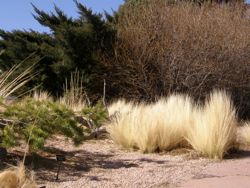 We are experiencing (yet) another dry winter here in the Pikes Peak area, and that means we get to participate in that unique western (or southwestern) gardening experience, winter watering.
We are experiencing (yet) another dry winter here in the Pikes Peak area, and that means we get to participate in that unique western (or southwestern) gardening experience, winter watering.
When I first bought my house here, it never occurred to me to put out the sprinkler at any point between October and May. Hence, after our second winter in the house, we lost half of the backyard – the half that was never shaded by the garage or the trees. Since then, I’ve learned that many plants in our area need to be watered during dry spells in the winter.
Why Water in Winter?
Yes, our plants are mostly dormant over the winter, and so it can seem strange to water when they aren’t actively taking up and transpiring water. So why do we do it? Well, even though the tops of most of our plants are looking pretty dead right now, they still (hopefully) have live roots in the soil. Those roots aren’t taking up water, but if the soil around them is dry, the soil will slowly take moisture from the roots, drying them completely. So, when we winter water, we’re actually watering the soil!
What Should I Water?
Well, we’ve established that you’ll actually be watering the soil to keep it from drying out plant roots. So, newer plants, ESPECIALLY new trees and shrubs, with less established root systems should be your first candidates for watering. Next, water any patches of Kentucky bluegrass turf, starting with those that are exposed to the most sun during winter. Kentucky bluegrass roots only grow into the top layer of soil, the layer that is first to dry out. Once you’ve taken care of new plants and bluegrass, other planted areas would appreciate some water too. Pay particular attention to places where you’ve planted new bulbs. Do you have garlic that you planted in the fall? Then check that area to see if it needs water too. Finally, check your empty veggie plots. They shouldn’t be allowed to go completely dry over winter either. (Fortunately, you probably wisely mulched them in the fall and they’ll be less likely to dry out, right?)
What Shouldn’t I Water?
Don’t water in areas where the ground is frozen. Don’t water in areas that are not dry. Don’t water in areas that have snow on them.
If you invested the time and energy (and money!) into planting a native grass lawn like buffalograss or blue grama grass, this is one of the times your effort will pay off. Don’t winter water native grass lawns. They’ve evolved to survive our variable winter moisture, and are completely dormant at this time of year. Watering, especially in late winter, may give weeds a jump start to get growing before the grass leaves winter dormancy.
When Should I Water?
During winter, if we go through a spell without moisture for a few weeks, check to see if your soil is dry by digging down a few inches in the areas that you plan to water. If it’s dry, it’s time. But don’t just drag out the hose! Winter watering can be a challenge because we have to wait for fairly specific conditions for it to be useful. First, the temperature needs to be over forty degrees. Second, it’s best to water in the middle of the day so the water has time to soak in. Watering later in the day will lead to water freezing quickly in the top layer of soil as the temperature drops. Third, and to me, this is the biggest challenge, it can’t be windy. Unless you are using soaker hoses, watering while it’s windy will just be a waste of your time and our precious water.
How?
Water slowly using an overhead sprinkler. You can use soaker hoses as well, but they take quite a bit longer and you may not be able to get everything watered in the limited time you have. Sprinkler output varies, but for new trees and shrubs, check to see that water has soaked down to ten-to-twelve inches after watering. For bluegrass, the water should penetrate about six inches.
Finishing Up
You should enjoy a nice feeling of satisfaction once you’ve completed a session of winter watering. Now, roll up and drain out your hoses and store them away for the next time. If your hose bibs are on the south side of your house and you leave your hoses out all winter, at least be sure to disconnect them from the bibs.
For more on winter watering in our area, check out the Colorado State University Extension’s Fact Sheet 7.211: Fall and Winter Watering
Contributed by Carey Harrington, Colorado Native Plant Master and Certified Colorado Gardener
Leave a comment